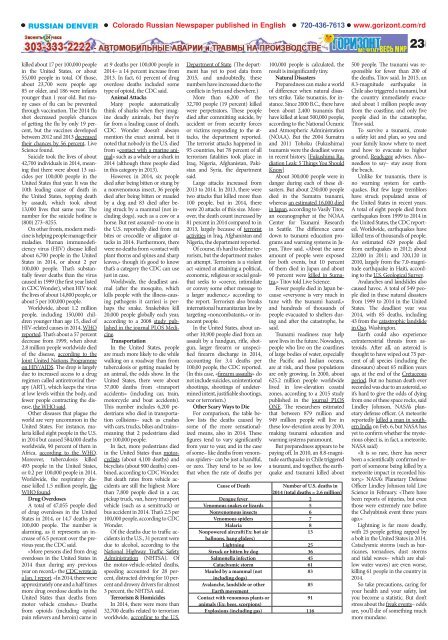Горизонт N6/835
Горизонт (газета) — (Gorizont англ. Horizon ) первая и наиболее влиятельная газета, издающаяся на русском языке в штатеКолорадо, США. Еженедельник, выходит по пятницам, формат Таблоид, 128 цветных и чернобелых страниц, распространяется в городах, составляющих метрополию Денвера (Большой Денвер), и в других населенных пунктах штата Колорадо от графства Саммит до графства Эль—Пасо. Полная электронная версия газеты «Горизонт» доступна в сети Интернет. Подробнее http://en.wikipedia.org/wiki/Gorizont_(newspaper)
Горизонт (газета) — (Gorizont англ. Horizon ) первая и наиболее влиятельная газета, издающаяся на русском языке в штатеКолорадо, США. Еженедельник, выходит по пятницам, формат Таблоид, 128 цветных и чернобелых страниц, распространяется в городах, составляющих метрополию Денвера (Большой Денвер), и в других населенных пунктах штата Колорадо от графства Саммит до графства Эль—Пасо. Полная электронная версия газеты «Горизонт» доступна в сети Интернет. Подробнее http://en.wikipedia.org/wiki/Gorizont_(newspaper)
Create successful ePaper yourself
Turn your PDF publications into a flip-book with our unique Google optimized e-Paper software.
RUSSIAN DENVER<br />
Colorado Russian Newspaper published in English 720-436-7613 www.gorizont.com/rd<br />
23<br />
killed about 17 per 100,000 people<br />
in the United States, or about<br />
55,000 people in total. Of those,<br />
about 23,700 were people age<br />
85 or older, and 186 were infants<br />
younger than 1 year old. But many<br />
cases of flu can be prevented<br />
through vaccination. The 2014 flu<br />
shot decreased people’s chances<br />
of getting the flu by only 19 percent,<br />
but the vaccines developed<br />
between 2012 and 2013 decreased<br />
their chances by 56 percent, Live<br />
Science found.<br />
Suicide took the lives of about<br />
42,700 individuals in 2014, meaning<br />
that there were about 13 suicides<br />
per 100,000 people in the<br />
United States that year. It was the<br />
10th leading cause of death in<br />
the United States, topping death<br />
by assault, which took about<br />
13,000 lives that same year. The<br />
number for the suicide hotline is<br />
(800) 273–8255.<br />
On other fronts, modern medicine<br />
is helping people manage their<br />
maladies. Human immunodeficiency<br />
virus (HIV) disease killed<br />
about 6,700 people in the United<br />
States in 2014, or about 2 per<br />
100,000 people. That’s substantially<br />
fewer deaths than the virus<br />
caused in 1999 (the first year listed<br />
in CDC Wonder), when HIV took<br />
the lives of about 14,800 people, or<br />
about 5 per 100,000 people.<br />
Worldwide, about 1.2 million<br />
people, including 150,000 children<br />
younger than age 15, died of<br />
HIV-related causes in 2014, WHO<br />
reported. That’s about a 57 percent<br />
decrease from 1999, when about<br />
2.8 million people worldwide died<br />
of the disease, according to the<br />
Joint United Nations Programme<br />
on HIV/AIDS. The drop is largely<br />
due to increased access to a drug<br />
regimen called antiretroviral therapy<br />
(ART), which keeps the virus<br />
at low levels within the body, and<br />
fewer people contracting the disease,<br />
the WHO said.<br />
Other diseases that plague the<br />
world are very uncommon in the<br />
United States. For instance, malaria<br />
killed eight people in the U.S.<br />
in 2014 but caused 584,000 deaths<br />
worldwide, 90 percent of them in<br />
Africa, according to the WHO.<br />
Moreover, tuberculosis killed<br />
493 people in the United States,<br />
or 0.2 per 100,000 people in 2014.<br />
Worldwide, the respiratory disease<br />
killed 1.5 million people, the<br />
WHO found.<br />
Drug Overdoses<br />
A total of 47,055 people died<br />
of drug overdoses in the United<br />
States in 2014, or 14.7 deaths per<br />
100,000 people. The number is<br />
alarming, as it represents an increase<br />
of 6.5 percent over the previous<br />
year, the CDC said.<br />
«More persons died from drug<br />
overdoses in the United States in<br />
2014 than during any previous<br />
year on record,» the CDC wrote in<br />
a Jan. 1 report. «In 2014, there were<br />
approximately one and a half times<br />
more drug overdose deaths in the<br />
United States than deaths from<br />
motor vehicle crashes.» Deaths<br />
from opioids (including opioid<br />
pain relievers and heroin) came in<br />
at 9 deaths per 100,000 people in<br />
2014– a 14 percent increase from<br />
2013. In fact, 61 percent of drug<br />
overdose deaths included some<br />
type of opioid, the CDC said.<br />
Animal Attacks<br />
Many people automatically<br />
think of sharks when they imagine<br />
deadly animals, but they’re<br />
far from a leading cause of death.<br />
CDC Wonder doesn’t always<br />
mention the exact animal, but it<br />
noted that nobody in the U.S. died<br />
from «contact with a marine animal»<br />
such as a whale or a shark in<br />
2014 (although three people died<br />
in this category in 2013).<br />
However, in 2014, six people<br />
died after being bitten or stung by<br />
a nonvenomous insect, 36 people<br />
died after being bitten or mauled<br />
by a dog and 83 died after being<br />
struck by a mammal (not including<br />
dogs), such as a cow or a<br />
horse. But rest assured– no one in<br />
the U.S. reportedly died from rat<br />
bites or crocodile or alligator attacks<br />
in 2014. Furthermore, there<br />
were no deaths from «contact with<br />
plant thorns and spines and sharp<br />
leaves,» though it’s good to know<br />
that’s a category the CDC can use<br />
just in case.<br />
Worldwide, the deadliest animal<br />
(after the mosquito, which<br />
kills people with the illness-causing<br />
pathogens it carries) is perhaps<br />
the snake. Snakebites kill<br />
20,000 people globally each year,<br />
according to a 2008 study published<br />
in the journal PLOS Medicine.<br />
Transportation<br />
In the United States, people<br />
are much more likely to die while<br />
walking on a roadway than from<br />
tuberculosis or getting mauled by<br />
an animal, the odds show. In the<br />
United States, there were about<br />
37,000 deaths from «transport<br />
accidents» (including car, train,<br />
motorcycle and boat accidents).<br />
This number includes 6,200 pedestrians<br />
who died in transportation<br />
collisions– such as crashes<br />
with cars, trucks, bikes and trains–<br />
meaning that 2 pedestrians died<br />
per 100,000 people.<br />
In fact, more pedestrians died<br />
in the United States than motorcyclists<br />
(about 4,100 deaths) and<br />
bicyclists (about 900 deaths) combined,<br />
according to CDC Wonder.<br />
But death rates from vehicle accidents<br />
are still the highest: More<br />
than 7,800 people died in a car,<br />
pickup truck, van, heavy transport<br />
vehicle (such as a semitruck) or<br />
bus accident in 2014. That’s 2.5 per<br />
100,000 people, according to CDC<br />
Wonder.<br />
Of the deaths due to traffic accidents<br />
in the U.S., 31 percent were<br />
due to alcohol, according to the<br />
National Highway Traffic Safety<br />
Administration (NHTSA). Of<br />
the motor-vehicle-related deaths,<br />
speeding accounted for 28 percent,<br />
distracted driving for 10 percent<br />
and drowsy drivers for almost<br />
3 percent, the NHTSA said.<br />
Terrorism & Homicides<br />
In 2014, there were more than<br />
32,700 deaths related to terrorism<br />
worldwide, according to the U.S.<br />
Department of State. (The department<br />
has yet to post data from<br />
2015, and undoubtedly, these<br />
numbers have increased due to the<br />
conflicts in Syria and elsewhere.)<br />
More than 6,200 of the<br />
32,700 people (19 percent) killed<br />
were perpetrators. These people<br />
died after committing suicide, by<br />
accident or from security forces<br />
or victims responding to the attacks,<br />
the department reported.<br />
The terrorist attacks happened in<br />
95 countries, but 78 percent of all<br />
terrorism fatalities took place in<br />
Iraq, Nigeria, Afghanistan, Pakistan<br />
and Syria, the department<br />
said.<br />
Large attacks increased from<br />
2013 to 2014. In 2013, there were<br />
two attacks that killed more than<br />
100 people, but in 2014, there<br />
were 20 attacks of this size. Moreover,<br />
the death count increased by<br />
81 percent in 2014 compared to in<br />
2013, largely because of terrorist<br />
activities in Iraq, Afghanistan and<br />
Nigeria, the department reported.<br />
Of course, it’s hard to define terrorism,<br />
but the department makes<br />
an attempt. Terrorism is a violent<br />
act «aimed at attaining a political,<br />
economic, religious or social goal»<br />
that seeks to «coerce, intimidate<br />
or convey some other message to<br />
a larger audience,» according to<br />
the report. Terrorism also breaks<br />
international humanitarian law by<br />
targeting «noncombatants,» or innocent<br />
people.<br />
In the United States, about another<br />
10,900 people died from an<br />
assault by a handgun, rifle, shotgun,<br />
larger firearm or unspecified<br />
firearm discharge in 2014,<br />
accounting for 3.4 deaths per<br />
100,00 people, the CDC reported.<br />
(In this case, «firearm assaults» do<br />
not include suicides, unintentional<br />
shootings, shootings of undetermined<br />
intent, justifiable shootings,<br />
war or terrorism.)<br />
Other Scary Ways to Die<br />
For comparison, the table below<br />
lists the deaths caused by<br />
some of the more sensationalized<br />
means, also in 2014. These<br />
figures tend to vary significantly<br />
from year to year, and in the case<br />
of some– like deaths from venomous<br />
spiders– can be just a handful,<br />
or zero. They tend to be so low<br />
that when the rate of deaths per<br />
100,000 people is calculated, the<br />
result is insignificantly tiny.<br />
Natural Disasters<br />
Preparedness can make a world<br />
of difference when natural disasters<br />
strike. Take tsunamis, for instance.<br />
Since 2000 B.C., there have<br />
been about 2,400 tsunamis that<br />
have killed at least 500,000 people,<br />
according to the National Oceanic<br />
and Atmospheric Administration<br />
(NOAA). But the 2004 Sumatra<br />
and 2011 Tohoku (Fukushima)<br />
tsunamis were the deadliest waves<br />
in recent history. [Fukushima Radiation<br />
Leak: 5 Things You Should<br />
Know]<br />
About 300,000 people were in<br />
danger during each of these disasters.<br />
But about 230,000 people<br />
died in the Sumatra tsunami,<br />
whereas an estimated 16,000 died<br />
in Japan, according to Vasily Titov,<br />
an oceanographer at the NOAA<br />
Center for Tsunami Research<br />
in Seattle. The difference came<br />
down to tsunami education programs<br />
and warning systems in Japan,<br />
Titov said. «About the same<br />
amount of people were exposed<br />
for both events, but 10 percent<br />
of them died in Japan and about<br />
90 percent were killed in Sumatra,»<br />
Titov told Live Science.<br />
Fewer people died in Japan because<br />
«everyone is very much in<br />
tune with the tsunami hazard,»<br />
and hundreds of thousands of<br />
people evacuated to shelters during<br />
and after the catastrophe, he<br />
said.<br />
Tsunami readiness may help<br />
save lives in the future. Nowadays,<br />
people who live on the coastlines<br />
of large bodies of water, especially<br />
the Pacific and Indian oceans,<br />
are at risk, and these populations<br />
are only growing. In 2000, about<br />
625.2 million people worldwide<br />
lived in low-elevation coastal<br />
zones, according to a 2015 study<br />
published in the journal PLOS<br />
ONE. The researchers estimated<br />
that between 879 million and<br />
949 million people will live in<br />
these low-elevation areas by 2030,<br />
making tsunami education and<br />
warning systems paramount.<br />
But preparedness appears to be<br />
paying off. In 2010, an 8.8-magnitude<br />
earthquake in Chile triggered<br />
a tsunami, and together, the earthquake<br />
and tsunami killed about<br />
Cause of Death<br />
Number of U.S. deaths in<br />
2014 (total deaths = 2.6 million)<br />
Dengue fever 2<br />
Venomous snakes or lizards 5<br />
Nonvenomous insects 6<br />
Venomous spiders 7<br />
Malaria 8<br />
Nonpowered aircraft(Ex: hot air<br />
13<br />
balloons, hang gliders)<br />
Lightning 25<br />
Struck or bitten by dog 36<br />
Salmonella infection 45<br />
Cataclysmic storm 61<br />
Mauled by a mammal (not<br />
83<br />
including dogs)<br />
Avalanche, landslide or other<br />
85<br />
Earth movement<br />
Contact with venomous plants or<br />
91<br />
animals (Ex: bees, scorpions)<br />
Explosions (including gas) 116<br />
500 people. The tsunami was responsible<br />
for fewer than 200 of<br />
the deaths, Titov said. In 2015, an<br />
8.3-magnitude earthquake in<br />
Chile also triggered a tsunami, but<br />
the country immediately evacuated<br />
about 1 million people away<br />
from the coastline, and only five<br />
people died in the catastrophe,<br />
Titov said.<br />
To survive a tsunami, create<br />
a safety kit and plan, so you and<br />
your family know where to meet<br />
and how to evacuate to higher<br />
ground, Ready.gov advises. Also–<br />
needless to say– stay away from<br />
the beach.<br />
Unlike for tsunamis, there is<br />
no warning system for earthquakes.<br />
But few large tremblors<br />
have struck populated areas of<br />
the United States in recent years.<br />
A total of eight people died from<br />
earthquakes from 1999 to 2014 in<br />
the United States, the CDC reported.<br />
Worldwide, earthquakes have<br />
killed tens of thousands of people.<br />
An estimated 629 people died<br />
from earthquakes in 2012; about<br />
22,000 in 2011; and 320,120 in<br />
2010, largely from the 7.0-magnitude<br />
earthquake in Haiti, according<br />
to the U.S. Geological Survey.<br />
Avalanches and landslides also<br />
caused havoc. A total of 549 people<br />
died in these natural disasters<br />
from 1999 to 2014 in the United<br />
States. The deadliest year was<br />
2014, with 85 deaths, including<br />
43 from the catastrophic landslide<br />
in Oso, Washington.<br />
Earth could also experience<br />
extraterrestrial threats from asteroids.<br />
After all, an asteroid is<br />
thought to have wiped out 75 percent<br />
of all species (including the<br />
dinosaurs) about 65 million years<br />
ago, at the end of the Cretaceous<br />
period. But no human death ever<br />
recorded was due to an asteroid, so<br />
it’s hard to give the odds of dying<br />
from one of these space rocks, said<br />
Lindley Johnson, NASA’s planetary<br />
defense officer. (A meteorite<br />
reportedly killed a man in southern<br />
India on Feb. 6, but NASA has<br />
yet to confirm whether the mysterious<br />
object is, in fact, a meteorite,<br />
NASA said)<br />
«It is so rare, there has never<br />
been a scientifically confirmed report<br />
of someone being killed by a<br />
meteorite impact in recorded history,»<br />
NASA’s Planetary Defense<br />
Officer Lindley Johnson told Live<br />
Science in February. «There have<br />
been reports of injuries, but even<br />
those were extremely rare before<br />
the Chelyabinsk event three years<br />
ago.»<br />
Lightning is far more deadly,<br />
with 25 people getting zapped by<br />
a bolt in the United States in 2014.<br />
Cataclysmic storms (such as hurricanes,<br />
tornadoes, dust storms<br />
and tidal waves– which are shallow<br />
water waves) are even worse,<br />
killing 61 people in the country in<br />
2014.<br />
So take precautions, caring for<br />
your health and your safety, lest<br />
you become a statistic. But don’t<br />
stress about the freak events– odds<br />
are, you’ll die of something much<br />
more mundane.

















